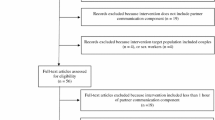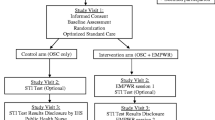Abstract
Sexual risk behavior interventions in sub-Saharan Africa focus predominantly on individual and couples counseling. This cognitive-behavioral group intervention was adapted from an urban US context to urban Zambia. Preliminary data analyses assessed the influence of partner participation on sexual risk behavior among HIV-positive Zambian women. Female participants (n=180) attended four group intervention sessions and received sexual behavior skill training and male and female condoms; male partners (n=152) were randomly assigned to high-or low-intensity genderconcordant group intervention sessions. Sexual risk behavior, strategies, attitudes, and knowledge were assessed at baseline, 6, and 12 months. At baseline, 19% of males reported using alcohol before sex, 10% reported using alcohol to cope, and negative coping was associated with sexual risk behavior. In contrast, 1% of women reported using alcohol before sex, and 15% used alcohol as an HIV-coping strategy. Consistent barrier use was reported by 48% of women and 74% of men. After intervention, female high intensity participants reported higher rates of condom use (F=5.68, P=.02), more positive condom attitudes, safer sex intentions, and less alcohol use. These findings highlight the influence of male partners in implementation of effective risk reduction interventions.
Similar content being viewed by others
References
UNAIDS. 2004 report on the global AIDS epidemic: executive summary. Available at: http://www.unaids.org/bangkok2004/GAR2004_html/ExecSummary_en/ ExecSumm_00_en.htm. Accessed July 14, 2004.
Central Statistical Office of Zambia. ANC Semtinel Surveillance of HIV/Syphilis Trends in Zambia 1994–2002. Lusaka, Zambia: Central Statistical Office of Zambia; 2002.
Hira SK, Feldblum PJ, Kamanga J, Mukelabai G, Weir SS, Thomas JC. Condom and nonoxynol-9 use and the incidence of HIV infection in serodiscordant couples in Zambia. Int J STD AIDS. 1997;8:243–250.
Fleming DT, Wasserheit JN. From epidemiological synergy to public health policy and practice: the contribution of other sexually transmitted diseases to sexual transmission of HIV infection. Sex Transm Infect. 1999;75:3–17.
Fidelli US, Allen SA, Musonda R, et al. Virologic and immunologic determinants of heterosexual transmission of human immunodeficiency virus type 1 in Africa. AIDS Res Hum Retroviruses. 2001;17:901–910.
Ministry of Health/Central Board of Health, Republic of Zambia, HIV/AIDS in Zambia. Lusaka, Zambia: Central Statistical Office of Zambia; September 1999.
Chikumbi B. Dry sex potentiates HIV and STD spread. Paper presented at: The Eleventh International Conference on AIDS and STDs in Africa (ICASA); September 12–16, 1999; Lusaka, Zambia.
Campbell T, Kelly M. Women and AIDS in Zambia: a review of the psychosocial factors implicated in the transmission of HIV. AIDS Care. 1995;7:365–373.
Fleishman J. Suffering in silence: human rights abuses and HIV transmission to girls in Zambia. Human Rights Watch. January 28, 2003. Available at: http://hrw.org/reports/2003/zambia/zambia1202.pdf. Accessed April 26, 2005.
Amaro H. Love, sex and power: advancements in research on the context of women’s HIV risk. Master lecture presented at: Society for Behavioral Medicine: April 7, 2000; Nashville, TN.
Roth DL, Stewart KE, Clay OJ, van der Straten A, Karita E, Allen S. Sexual practices of HIV discordant couples in Rwanda: effects of a testing and counseling program for men. Int J STD AIDS. 2000;12:181–188.
Carael M, Holmes KK. Dynamics of HIV epidemics in sub-Saharan Africa: introduction. AIDS. 2001;15(suppl 4):S1-S4.
Allen SA, Karita E, N’gandu N, Tichacek A. The evolution of voluntary testing and counseling as an HIV prevention strategy. In: Gibney L, DiClemente RJ, Vermund SH, eds. Preventing HIV in Developing Countries: Biomedical and Behavioral Approaches. New York, NY: Plenum Press; 1999.
Allen S, Meinzen-Derr J, Kautzman M, et al. Sexual behavior of HIV discordant couples after HIV counseling and testing. AIDS. 2003;17:733–740.
DiClemente RJ, Wingood GM. A randomized controlled trial of an HIV sexual risk-reduction intervention for young African-American women. JAMA. 1995;25:1271–1276.
Rugpao S, Koonlertkit S, Pinjaroen S., et al. Patterns of male condom use and risky sexual behaviors in Thai couples receiving ongoing HIV risk reduction counseling. Paper presented at: XV International AIDS Conference 2004; July 11–16, 2004; Bangkok, Thailand. Abstract ThPeC7408.
Jones DL, Weiss SM, Bhat GJ, Feldman DA, Bwalya V, Budash D. A sexual barrier intervention for HIV+/-Zambian women: acceptability and use of vaginal chemical barriers. J Multicultur Nurs Health. 2004;10:27–33.
Jones DL, Weiss SM, Malow R, et al. A brief sexual barrier intervention for women living with AIDS: acceptability, use and ethnicity. J Urban Health. 2001;12:593–604.
Azjen I, Fishbein M. A Bayesian analysis of attribution processes. Psychol Bull. 1985;82:261–277.
Ajzen I. From intentions to actions: a theory of planned behavior. In: Kuhl J, Beckman J, eds. Action-Control: From Cognition to Behavior. Heidelberg, Germany: Springer: 1985:11–39.
Albarracin D, Johnson BT, Fishbein M, Muellerleile PA. Theories of reasoned action and planned behavior as models of condom use: a meta-analysis. Psychol Bull. 2001;127:142–161.
Meyer-Bahlberg HFL, Ehrhardt AA, Exner TM, Gruen RS. Sexual Risk Behavior Assessment Schedule: Adult (SERBAS-A-DF-4) Manual. New York: Psychological Press; 1990.
Kalichman SC. HIV-AIDS: Prevalence, predictors, and emerging clinical interventions. Clin Psychol. 2000;7:32–47.
Kalichman SC, Carey MP, Johnson BT. Prevention of sexually transmitted HIV infection: a meta-analytic review of the behavioral outcome literature. Clin Psychol Rev. 1996;17:271–291.
Helweg-Larsen M, Collins BE. The UCLA Multidimensional Condom Attitudes Scale: documenting the complex determinants of condom use in college students. Health Psychol. 1994;13:224–237.
Carver C. You want to measure coping but your protocol’s too long: consider the Brief COPE. Int J Behav Med. 1997;4:92–100.
Carver C, Scheier M, Weintraub JD. Assessing coping strategies: a theoretically based approach. J Pers Soc Psychol. 1989;56:267–283.
Author information
Authors and Affiliations
Corresponding author
Rights and permissions
About this article
Cite this article
Jones, D.L., Ross, D., Weiss, S.M. et al. Influence of partner participation on sexual risk behavior reduction among HIV-Positive Zambian women. J Urban Health 82 (Suppl 4), iv92–iv100 (2005). https://doi.org/10.1093/jurban/jti111
Issue Date:
DOI: https://doi.org/10.1093/jurban/jti111




